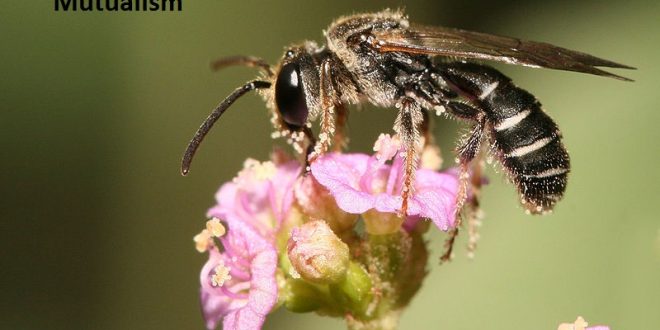POPULATION INTERACTIONS
Population is a group of individuals of the same species. An organism cannot live in isolation, interaction always occurs. This interaction can be beneficial, harmful or neutral. ‘+’ marks positive interaction, ‘-‘marks negative interaction and ‘0’ marks neutral interaction.
The common interactions are:
- Mutualism (+, +)
- Competition (-, -)
- Predation (+, -)
- Parasitism (+, -)
- Commensalism (+, 0)
- Amensalism (-, 0)
MUTUALISM: It can be defined as an interaction between the two individuals where both the individuals are benefitted with each other. For e.g., lichens are formed by the interaction of algae and fungi. Both algae and fungi are benefitted by each other. Algae provides energy rich carbohydrates to the fungal partner, in return, fungus helps the algal partner in the absorption of essential nutrients from the soil.

COMPETITION: An interaction between the 2 organisms for the same resource leads to loss of an organism that is weak in strength; overall it affects (harmful) both of the organisms. For e.g. Flamingoes and fishes visit some water sources in South America for their common food, the zooplankton. Who-so-ever will get the food will survive, the life of the others will also be affected.
PREDATION: An interaction between the 2 organisms, where one is benefitted and the other is at loss is known as predation. For e.g. the predator and the prey relationship between the tiger and the deer. The predator, tiger is benefitted as he is getting food and the prey is at loss because it has become the food of predator.
PARASITISM: An interaction between the 2 organisms, where one is benefitted and the other is at loss is known as parasitism. Parasites reside on/in the living hosts. Ectoparasite reside outside the body and endoparasite reside inside the body. For e.g liver fluke is an example of an endoparasite that reside in the human body and harms, however, the liver fluke is benefitted by getting food.
COMMENSALISM: In this interaction, one species is benefitted and the other is neither benefitted nor at loss. For e.g. the relationship between clown fish and the sea anemone. Clown fish is benefitted because it gets protection from the predators, however, the sea anemone does not derive any benefit from the clown fish.
AMENSALISM: In this interaction, one species is harmed and the other is neither benefitted nor at loss, like in antibiosis, one organism produces the chemical which kills the other but is not harmful to the one that produces it. For e.g. the fungus Penicillium produces the chemical that kills the other organisms but this chemical is non-toxic to this fungus.
Questions:
Q1. Identify commensalism, from the given symbols:
- +, –
- +, +
- +, 0
- -, –
Ans. c
Q2. Identify amensalism, from the given symbols:
- +, –
- +, +
- +, 0
- -, 0
Ans. d
Q3. Identify parasitism, from the given symbols:
- +, –
- +, +
- +, 0
- -, 0
Ans. a
Q4. Identify predation, from the given symbols:
- +, –
- +, +
- +, 0
- -, 0
Ans. a
Q5. Identify mutualism, from the given symbols:
- +, –
- +, +
- +, 0
- -, 0
Ans. b
Q6. Identify competition, from the given symbols:
- +, –
- +, +
- +, 0
- -, –
Ans. d
 IT2EDU Empowering Education Through Technology
IT2EDU Empowering Education Through Technology


